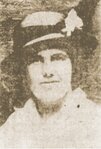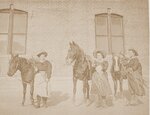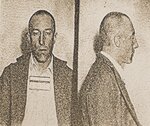




On a crisp, Fall day in 1915, the residents of Grant County began their day as usual, unaware that fear was about the sweep through the region like wildfire. One of the most heinous crimes in the county's history was about to unfold, forever marking October 22 as a day of infamy.
That Friday morning, Nellie Byers, a young teacher, was on her way to the Waterford School, located in the southeastern corner of the county. Nellie, the daughter of Frank and Lucy Byers, had grown up in Ulysses, where her father worked as a local blacksmith. Known for her bright spirit and ambition, she was a graduate of the local high school and had attended the state Normal School before returning to teach. Her passion for education and dedication to her students was well-known.
After teaching at the Doby School, Nellie was transfered to the Waterford Joint District 1 School, which served students from both Grant and Stevens counties. Despite earning a modest salary of $60, she was provided room and board at the Fred Edison farm, just two miles from the schoolhouse. Outside of work, Nellie enjoyed an active social life, staying connected with friends from her Ulysses days. That day, she looked forward to visiting her sister, Alice, at the Brewer household and planned to head into town on Saturday for a shopping trip.
Nellie was last seen around 5 p.m., closing up the school and walking barefoot across the river on her way north. However, by 9 p.m., her friend, Agnes Brewer, and sister, Alice, became worried when she hadn't arrived. They rode to the Edison farm, thinking she might have been delayed helping a student, and left a horse for her. The next morning, when they realized the horse had not been touched, they raised the alarm, fearing the worst.
A group of local men, including Ernest Linegar, James Lahey, Tobe Brewer, and Fred Edison, set out to search for Nellie. They soon discovered signs of a struggle along the trail, and following the tracks west, they found Nellie's lifeless body in a ravine, partially covered with weeds. The men immediately called for the county coroner, Dr. George Brewer, who rushed to the scene, ensuring no evidence was disturbed. Suspicion quickly turned to a nearby dugout home of the Henson family.
Dr. W. C. Brownell from Moscow arrived to assist in the investigation. Nellie's clothing and pocket watch were missing, and evidence suggested she had fiercely fought back before being killed. Dr. Brewer took special care to measure the footprints at the scene, using a set of straws, hoping they might help identify the murderer.
News of the crime spread quickly, sending a wave of fear through the county. Was there a killer on the loose? Bloodhounds were brought in from Concordia, and railroad stations were alerted to watch for suspicious passengers. On October 23, a member of the Hanson family approached authorities in Ulysses with a bizarre question: "would her life insurance policy pay out if Archibald 'Archie' Sweet, a man living with the Hensons, was lynched?"
Archie Sweet, originally from Fort Scott, had a troubled past. As a teenager, he had been jailed for assault and later imprisoned for stealing a team of horses. It was during this time in prison that he befriended Clint Henson, a man with a long criminal history, including assault, robbery, and even blowing up a train depot. Although Clint had been imprisoned indefinitely for blowing up the train depot, he was ultimately pardoned. After his release, Archie moved in with the Henson family, providing financial support to them.
On the day of Nellie's murder, Archie had been hunting rabbits and Clint had been helping a group harvest crops earlier in the day. The rest of the Hensons had gone into town for a literary club. After Nellie's body was discovered, Clint and Archie were among those who helped transport her remains. But when Dr. Brewer compared the straw measurements to Clint's shoes, they matched perfectly - and since the Hensons often shared clothing, it also implicated Archie.
As the investigation continued, a Burns detective named Wilkinson was brought in. His use of new investigative techniques, like bite mark analysis, revealed further evidence. However, the sheriff refused to issue a warrant for Clint Henson's arrest, frustrating Wilkinson, who believed the local authorities were protecting the Hensons.
Then, on November 16, Archie Sweet was charged with Nellie's murder. His whistling when the authorities arrived at the crime scene, coupled with the fact that the bloodhounds had tracked the scent to the Henson house, was considered enough evidence to implicate him. Under intense pressure and threat of being lynched, Archie was coerced into waiving his preliminary hearing, a decision that sealed his fate.
The trial, which began May 24, 1916, was moved to Syracuse and was surrounded with large public interest. The entire population of Grant County, except for a single bank teller, relocated to Syracuse to witness the proceedings. The courtroom was moved into an auditorium that was packed as testimony unfolded. All the witnesses were allowed to stay present throughout the hearing, and even still the Henson family's accounts varied wildly. With feelings being high Archie was found guilty of first degree murder on June 3, 1916. He was sentenced to life in Lansing Prison, where he would proclaim his innocence until his death in 1930.
Despite the conviction, many believed Archie was wrongfully accused, and efforts were made to appeal the case. However, the Kansas Supreme Court upheld the jury's decision, bringing a tragic chapter in Grant County's history to a close.
After Nellie's death, the Waterford School was closed for two years, and the building was eventually moved to Vanceville in Stevens County. Grant County Teacher's Association honored Nellie's memory by raising funds for a headstone at her grave, and her story became part of local folklore, with some claiming that her spirit wanders along the Cimarron River to this day.
The murder of Nellie Byers left a deep scar on the history of Grant County, not only for the brutality of the crime, but also for the sense of injustice that lingered in its aftermath. A bright and promising teacher, Nellie's death marked the loss of a life dedicated to the betterment of her community. Her tragic end, along with questionable trial that followed, reflected the complexities of a small town grappling with fear, anger, and the urgent need for justice. As her story lives on in both historical records and local folklore, it serves as a somber reminder of the fragility of life and the lengths to which communities will go in their pursuit of truth and closure.
Comments
No comments on this item Please log in to comment by clicking here